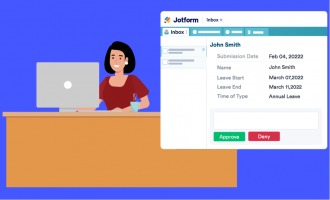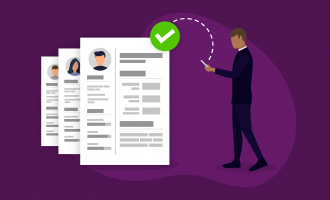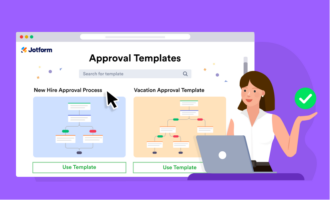5 essential human resources processes
Does your company have efficient, streamlined processes for hiring and managing employees? While each organization is unique, there are core human resources processes that most companies should have in place. Here’s an overview of the essential processes of an effective HR department — along with a way to manage and automate them.
1. Recruiting
Your organization needs a process for not only connecting with potential job candidates, but also for narrowing down the list of candidates and sending offers to those you want to hire. When your organization needs to fill a newly vacant position or create a new one, the right recruiting processes help you manage all the tasks associated with finding and hiring the right people.
Just so you know…
Power your HR department with Jotform’s online forms and automation tools. Collect job applications, onboard new hires, and more!
Recruiting systems include a variety of steps, including managing
- Job postings
- Interviews
- Candidate assessments
- Reference checks
The goal of these processes is to narrow down the list of résumés and pick the best fit for the open position. Effective processes align hiring practices with the staffing plan and organizational goals.
2. New-hire onboarding
Once you finalize a hiring decision, it’s time to onboard the new hire. Onboarding isn’t just about collecting essential paperwork and benefits information — it’s also a vital time for setting up each new employee to succeed. In addition, an effective onboarding process sends a message about your business and company culture.
An onboarding checklist helps you ensure that you don’t overlook any essential steps. Here are a few crucial tasks to add to your checklist:
- Finalize the new hire’s start date and training schedule
- Collect new employee paperwork
- Inform departments about the incoming employee
- Prepare an office space and equipment for the new hire
- Create new hire logins and accounts
- Inform new employees about benefits and policies
Pro Tip
Looking to make new hire training more engaging and scalable? Jotform Presentation Agents offer a smart, self-guided way to onboard employees with interactive, AI-powered presentations, no live presenter required.
3. Employee training
Employees often go through a training period when they start a new position. But training doesn’t need to end once an employee is capable of performing their essential job duties. Ongoing employee training keeps your team productive and their skills up to date.
Make training a priority, not a last resort to improve poor performance. Offering learning and development opportunities helps improve employee satisfaction and boost productivity. Incorporate these essential steps into your ongoing training processes:
- Use data from performance management systems to identify training gaps
- Schedule training programs
- Manage training attendance and completion lists
- Track HR metrics to measure the success of training efforts
4. Performance management
Performance management is about more than just ensuring that employees are productive. It’s also crucial to aligning employees with organizational goals and getting employee feedback on whether they feel engaged and supported in their work.
Most businesses used to conduct annual performance reviews. Unfortunately, these types of reviews only address issues once a year, and that’s often too late to address poor performance. Now, modern companies are integrating performance management as an ongoing practice to support employees throughout the year.
Consider adding these activities to your HR processes to support your workforce better:
- Set goals and performance measures for each employee
- Align communication with employees, managers, and other staff members
- Schedule regular check-ins and performance conversations
- Provide constructive feedback and recognition for employees
5. Employee offboarding
If you’re effective with your hiring and employee development practices, your company will benefit from low turnover. But there will still be times when employees must move on. Whether a person quits or you let them go, your employee offboarding process streamlines the steps to care for the needs of the employee and protect your company at the same time.
Offboarding processes help reduce the impact of an employee leaving the company. Consider adding these tasks to your offboarding checklist:
- Complete an exit interview to get employee feedback
- Administer benefits, such as health insurance continuation and paid time off (PTO) payouts
- Collect essential documents related to the departure, like the employee’s termination letter
- Facilitate conversations to transfer critical information to other employees
Automate human resources processes with Jotform
Jotform is a valuable resource for automating your human resources processes. It offers human resources form templates to help you with everything from accepting and tracking job applications to conducting exit interviews. You can use Jotform’s free human resources table templates to manage and review the information you receive through form submissions. Finally, automate your HR processes using approval workflows to systematize approvals and collaboration.
This three-part system makes it easy to perform every part of your human resources processes seamlessly.














































Send Comment: